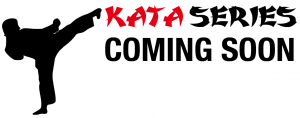 Jion forms part of the “Jion Kata Group.” This kata group consists of Jion, Ji’in, and Jutte. It is a popular kata choice for competition, particularly because it is a kata that exhibits many of the traditional Shotokan stances: zenkutsu dachi (front stance) and kiba dachi (horse stance). It begins in the kamae of the left hand covering the right, reminiscent of Chinese boxing, from which it is believed the kata origniated.
Jion forms part of the “Jion Kata Group.” This kata group consists of Jion, Ji’in, and Jutte. It is a popular kata choice for competition, particularly because it is a kata that exhibits many of the traditional Shotokan stances: zenkutsu dachi (front stance) and kiba dachi (horse stance). It begins in the kamae of the left hand covering the right, reminiscent of Chinese boxing, from which it is believed the kata origniated.
Whilst little is known about Jion’s true history, it is believed that these katas began life in Chinese “Gung-fu”, moving towards the Japanese islands and further propagated in the Tomari region, where it was taught as part of the Tomari-te school (a branch of Okinawan martial arts taught in the Tomari village). The island of Okinawa is where modern karate began. These katas are referred to as the “Temple katas” because they are believed to have been practised in the Jion Temple, where martial arts were studied.
Meanings
“Jion” means “Mercy”; Ji’in translates as “Inverted Mercy”; and “Jutte” is “Ten Hands,” its mastery being that the practitioner should be able to face ten opponents.
Significance of Jion
Jion is a staple at competitions and examinations. Jion teaches a karateka rotational movements and directional shifts, characterized by its 45˚ movements at the opening, and linear segments that are broken by sharp 90˚ twists. It is an exceptionally basic, yet powerful kata, possessing a sense of grandeur. Nothing is hidden in the kata; it is honest, and should be practiced with such a spirit. The kata has a significant break-point midway through, where the karateka may, in a sense, recompose themselves in anticipation for the final movements of the kata. At this point, the kata seems to pause, setting-up for the explosive forward-momentum movements that drive the defense to its conclusion.
This is the first part of our Kata Series. Let us know which Shotokan katas you’d like to learn more about by leaving a comment below.

 Kata is an essential part of every karateka’s training. At SKKSA, we place special emphasis on the study of kata as it forms the platform on which our training is based. Without kata, the practice of karate lacks focus. And, after all, kata is as beautiful as poetry, as evidenced by practitioners that compete at the highest levels.
Kata is an essential part of every karateka’s training. At SKKSA, we place special emphasis on the study of kata as it forms the platform on which our training is based. Without kata, the practice of karate lacks focus. And, after all, kata is as beautiful as poetry, as evidenced by practitioners that compete at the highest levels.